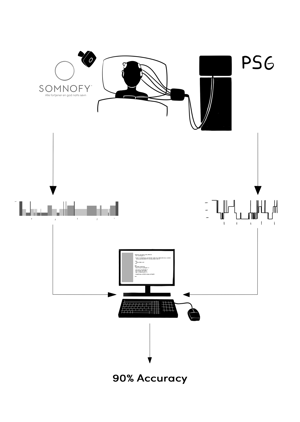Denne artikkelen er en forlenget abstract til vår publiserte valideringsstudie. Informasjonen er kun tilgjengelig på engelsk.
Validation studies are performed to test the validity or accuracy of one measurement against an accepted gold standard. In the case of sleep measurements any sleep assistant or device claiming to measure sleep should be validated against polysomnography, the medical norm for objective sleep assessments.
To perform a validation study, the device to be tested needs to measure the same study participant as PSG at the same time. Then comparing the data sets in hindsight can give an idea about how much they align.
This is the study method for proving the validity of the measurements performed by the non-contact sleep assistant Somnofy [1]. You can find the full-text article here.
71 healthy, mostly young individuals spent a night at the sleep laboratory and their sleep was measured by both PSG and Somnofy. The study aimed to validate both quantitative sleep parameters as well as qualitative sleep staging of wakefulness, light sleep and deep sleep and REM sleep. Five sleep specialists took part in manual scoring of PSG and each recording was scored separately by two sleep specialists.

Results
The agreement on quantitative sleep parameters between Somnofy and PSG was very good. Measuring light sleep stage and total sleep time, Somnofy was about as reliable as PSG [1]. Somnofy correctly identified if a person was sleeping (vs. being awake) in 97% of all time periods, and correctly identified if a person was awake (vs. being asleep) in 72% of all time periods. This latest point is especially worth noting as correctly classifying people being awake when they lie completely still is difficult for non-EEG-based sleep monitors — these typically correctly classify 34-65% of those time periods [2].
The detailed analysis of the sleep staging abilities of Somnofy reveal a substantial agreement with PSG across all four sleep stages. Somnofy accurately detected light sleep in 75% of time periods, deep sleep in 74% and REM in 78% of time periods compared to PSG. The overall average disagreement was 1 minute for light sleep, 12 min for deep sleep and 11 min for REM sleep compared to how much the manual PSG scorers agreed. Distinguishing between the sleep phases with non-EEG based systems has been and still is challenging. The sleep stage differentiation of Somnofy was more precise than that of other non-EEG technology providing sleep stages as Fitbit Charge 2 [3], Oura ring [4] and Resmed S+ [5].
Summary
The validation study proves the ability of Somnofy to estimate sleep and wake in a healthy and mostly young population. Compared to manually scored PSG, Somnofy scored sleep/wake robustly with 97% of sleep periods and 72% of wake periods scored correctly. The sensitivity and specificity are like that of simplified PSG solutions that only use frontopolar EEG. The challenge for non-intrusive sleep tracking devices is to reliably detect wakefulness. Somnofy shows the highest specificity compared to other non-EEG systems, including other contactless monitoring devices that use technology based on passive infrared, sonography, pressure sensation or ballistocardiography.
The results show that while PSG remains the reference method for sleep scoring, Somnofy showed high precision in an automated and non-invasive way. The hypnograms from Somnofy provide good reliability of the night’s sleep quality. This could make Somnofy an adequate alternative to PSG for longitudinal studies on healthy adults as the cost, scalability and user simplicity is advantageous over PSG.
References:
- Toften S, Pallesen S, Hrozanova M, Moen F, Grønli J: “Validation of sleep stage classification using non-contact radar technology and machine learning (Somnofy®)”, available online 6 March 2020, epub ahead of print, Sleep Medicine. DOI: 10.1016/j.sleep.2020.02.022
- de Souza L, Benedito-Silva AA, Pires MLN, Poyares D, Tufik S, Calil HM. Further Validation of Actigraphy for Sleep Studies. Sleep. 2003;26(1):81-85
- Walch O, Huang Y, Forger D, Goldstein C. Sleep stage prediction with raw acceleration and photoplethysmography heart rate data derived from a consumer wearable device. Sleep. 2019.
- de Zambotti M, Rosas L, Colrain IM, Baker FC. The Sleep of the Ring: Comparison of the OURA Sleep Tracker Against Polysomnography. Behav Sleep Med. 2019;17(2):124-136.
- Schade MM BC, Murray BR, Gahan L, Doheny EP, Kilroy H, Zaffaroni A, Montgomery-Downs HE. Sleep Validity of a Non-Contact Bedside Movement and Respiration-Sensing Device. J Clin Sleep Med. 2019;15(7):1051-1061.
